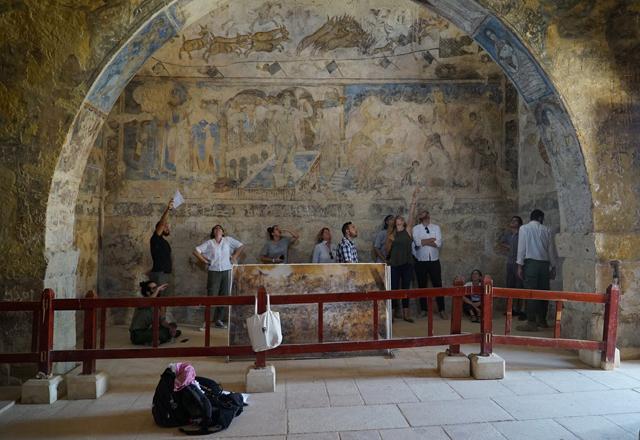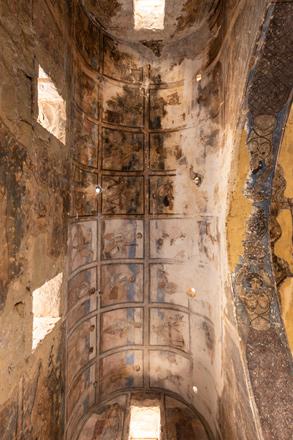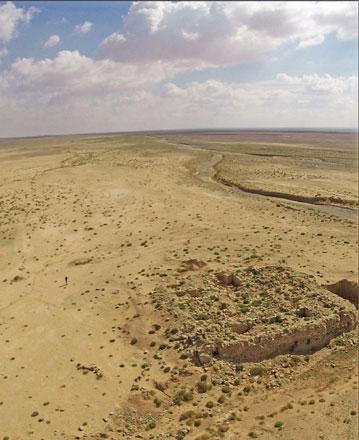You are here
Qusayr Amra: A jewel of Umayyad art and architecture revealed through restoration
By Saeb Rawashdeh - Jan 12,2024 - Last updated at Jan 13,2024

The aisle decoration depicts craftsmen in everyday work: carpenters, blacksmiths and stonemasons (Photo courtesy of ACOR)
AMMAN — Qusayr Amra, located approximately 80 kilometres east of Amman, is one of the desert castles typical for the early Islamic period and the complex was built between 723AD and 743AD by Prince Walid, who would later become Umayyad Caliph Walid II (709-744). Qusayr Amra represents one of finest examples of Umayyad art and architecture known for its lavish and sophisticated paintings.
The abandoned structure was rediscovered by a Czech explorer Alois Musil (1868-1944) and the series of restoration works have been conducted from the 1970s. The structure did not have a military purpose but was more a private residence for Prince Walid, and the building consisted of a triple-aisled audience hall, with a three-room bathing suite added. Walls are covered with paintings which subjects range from composing music, hunting and dancing. Also the images of the patron and other rulers are presented.
In 2019, a team of Italian conservator from the Italian Istituto Superiore per la Conservazione ed il Restauro removed over-painting revealing the original work.
“The bathhouse was part of a larger settlement, including elite residential building, several smaller residences, a mosque, possible industrial buildings and a walled garden, none of which are still standing,” said British art historian Beatrice Leal.
The complex is one of a number of early Islamic rural sites, recreational or residential, collectively known as desert palaces.
“The term ‘desert’ is slightly misleading; although generally situated near the edge of the desert, some of the most prominent features of these sites were their oasis-like settings, irrigated gardens, fountains and ornamental reservoirs, using either permanent or seasonal water supplies. As Qusayr Amra lies on the Wadi el Butum, which supplied the site with water during rainy seasons; it was also provided with a camel-drawn well and a cistern,” Leal noted, adding that a bathhouse in the arid area of the Jordanian steppe was in itself a display of constant water supply.
Prince Walid was very skillful in controlling water in a dry climate, and water is one of the dominant themes of decorations at Qusayr Amra.
“Sea scenes, river scenes and images of bathing are dotted around the walls of the audience hall and bathrooms, occupying some of the most prominent locations,” Leal underlined.
Furthermore, the arrangements of different subjects is complex, and at first sight almost random; nevertheless, patterns and themes can be discerned when the decoration is seen as a whole.
At Qasayr Amra, water was a symbol of blessings, wealth and abundance. These concepts were highlighted by frescos while original characteristic of Umayyad art added a new quality to the site.
“Rather than simply copying or even misunderstanding earlier forms of art, early Islamic patrons purposefully reshaped and adapted motifs and themes to project their new identity as rulers. In particular, a renewed interest in antique culture is apparent in the subjects of the paintings, as is a new interaction with the expressive potential of the human body. Finally, the overall themes of the painted programme at Qusayr Amra, running through the decoration of the audience hall, the bathing rooms and chambers beside the throne niche, are transformation and transcendent,” Leal underlined.
In 1985 Qusayr Amra was placed on the World Heritage List of UNESCO.
Related Articles
AMMAN — The Second Janet Abu Lughod seminar, organised by Studio-X Amman and Sijal Institute for Arabic Language and Culture was a “wonderfu
AMMAN — The desert castle Qasr Amra (or Qusayr Amra), located 25 kilometres west of Azraq, is one of the most important monuments in J
AMMAN — Qasr Mushash, located 40 kilometres east of Amman, was probably used for postal services during the Umayyad period, according to a G


















